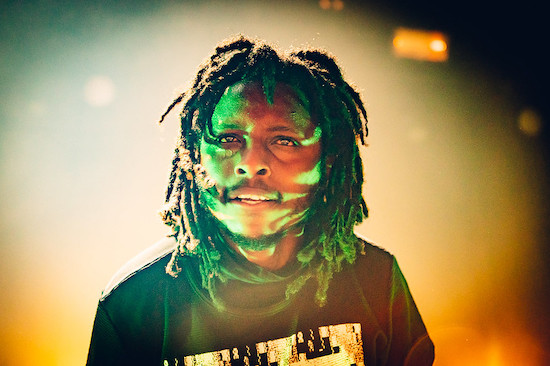Lord Spikeheart of Duma / Scotch Rolex, by Maarten Mooijman
A Game Of Two Halves
The mither starts the second international guests disembark from the Eurostar. Phones ping with disturbing and irritating, news bulletin-transmitted COVID rumours. It seems Her Majesty’s Govt. are not alone in their habit of leaking amplified bad news to the press hours before holding a conference announcing, miraculously, that things are not as bad as everyone feared. A sop to the credulous, a further insult to everyone else. If the rumours we’re hearing in the Netherlands are to be taken at face value, Le Guess Who? – one of the finest festivals on the European circuit – may be cancelled on day two, but who knows what it actually means – best to just dive in and experience as much as humanly possible while going is good.
Rian Treanor was one of three producers who worked with artist and video director Leila Ziu on her Altered States On The Dancefloor project earlier this year, which imagined three different rooms at a virtual rave. I’m not sure which room in the virtual rave Treanor was supposed to be occupying but IRL he’s on the very roomy stage of Tivoli Vredenburg’s Grote Zaal. It’s always informative, slightly amazing and incongruous to watch acts who you may think of as being underground in such mainstream, capacious settings as part of the LGW? line up. Treanor and Ziu stand to one side, ceding the floor to an unnamed dancer, encased in a billowing, amorphous, globular outfit which, bar fingertips and feet, encases them entirely. The conceit is simple and effective. The dancer’s exertions – no doubt moves we’d like to associate with the sweaty throng of a rave – are partially obscured by the prophylactic costume. How long until we can tear this layer away? Treanor summons up a satisfying soundtrack of puchy footwork, arpeggiated slabs of analog synth pushed through numerous sweeps of a comb filter and phase modulation. Great boinging struck tones of sheet glass, hollow wood and thin metal piping accompany a shift of gear from the radiophonic to John Carpenter of the early 80s before terminating in much more contemporary terrain with thunderous subs and a jerking whirlwind of snare hits and kicks. A rousing start.
What Taja Cheek, aka L’Rain, does is unique. Her performance tonight takes the relatively processed sound of this year’s Fatigue and renders it relatively organic for the live arena. The show in total is simultaneously arresting while still highly suggestive that there is much more to come. Tonight the Brooklyn-based musician combines different well-established affects and genres adroitly in a similarly shocking manner to Eric Chenaux. Her world-weary but amber-smooth vocal – which wouldn’t be out of place at, say, the Jazz Cafe – finds oddly satisfying counterpoint from her live band who are somewhere between modern jazz outfit and pitch bent shoegazers or whacked psych funk band. Whoever they are, they know all of the right wrong notes. As her own laughter is looped and stretched into multiple shapes before being sent pinging off around the venue over incongruous if pleasing fusion, I’m briefly presented with the exciting idea of Minnie Riperton fronting Weather Report being complimented by a live dub from Nurse With Wound’s Stephen Stapleton, provoking the giddy airborne feeling when the microdose turns out to be not that micro after all.
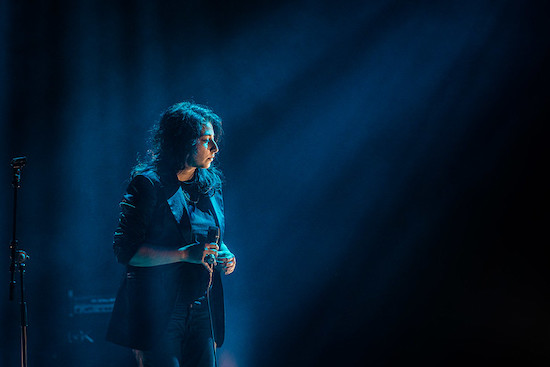
Arooj Aftab by Ben Houdijk
Pakistan-born and New York-resident Arooj Aftab is the last word in cool. She sips from a brimful glass of red wine which makes one fret about half-remembered stuff to do with the parching of vocal cords. It’s the last night of a world tour and she praises the audience for seeming alive: “Often people find this music so intense they end up quite scared [of making a sound]. They think it’s all about a devotional experience but really these songs are about love and intoxication.” Her lyrics may be derived from Sufi poetry but this isn’t really traditional music, let alone battle recreation as she contemporises Pakistani and Indian semi-classical traditions, tonight performing with Shahzad Ismaily on double bass and Maeve Gilchrist on harp. Aftab lets solely Anglophone listeners like me peer briefly under the hood of her process by singing ‘Last Night’ in English, in slowly accumulating increments: “Last night… my beloved… was like the moon… so beautiful… like the moon.” But with no disrespect meant to Rumi, she could be singing anything for the rest of the show, as far as I’m concerned, as often is the case with international music, my connection to the voice is primarily one of form not substance. Of course, she isn’t singing just ‘anything’, the songs on recent album Vulture Prince inspired by a family bereavement, but this is still an example of how art can thrive so vigorously in the gap between intent and interpretation. To hear her sing is to, momentarily, angrily, reject all that Roland Barthes said about the grain of the voice as Aftab has distilled her vocalisation until no grain at all remains, and her song has become a pure – elevated and elevating – expression of style as shining moral imperative. Her voice is not simply polished but burnished until one feels one may momentarily catch a reflection of the wonder of existence reflected in it, no matter how briefly. Her voice, a true intoxicant for those of us who no longer imbibe.
On the way to the next venue, quick-witted and eagle-eyed Quietus audio expert Alannah Chance, spots a suspiciously smoking object in a town square and expertly prevents your hapless correspondent from treading on it just seconds before it flashes brightly and emits the kind of sonic crack one imagines would accompany an existentially troublesome explosion at Cern’s Large Hadron Collider. Students in garish ‘80s disco’ outfits snicker at the look of shock on our faces at their firework prank. Dutch Halloween is an altogether more anarchic, less child-friendly celebration than the American or British equivalent it would seem. But an almighty bang is a good way to get in the mood for Scotch Rolex, who provide the party set of the festival. DJ Scotch Egg, lays down the (relatively) sophisticated mix of bassmusic, breaks, dancehall and drill with sporadic dopamine cache-busting deployments of gabber bolstered with chest concaving sub pulses, while Kenyan vocalist MC Yallah eventually whips the crowd into an explosive frenzy. When Lord Spikeheart takes over vocal duties, Scotch Rolex switches into “extreme metal” mode and then have much more ground to cover with the audience who, at first, seem to need to stop and adjust to the new, much higher BPM, swaying hypnotically to this grindbient or deathchill until locating a new, quarter step groove and eventually the dance restarts with all converted to this Japan meets Kenya meets Uganda by way of the Berghain and a Bangface weekender vision.
John Doran
Traditional Music Is Post Punk
“Traditional music shouldn’t be thought of as ‘old’; it’s a practice that continues, just like post-punk.” Such were the thoughts of Bulat Khalilov, co-founder of the Ored Recordings label, before the show of Zaur Nagoy and JRPJEJ in the Jacobikerk. Khalilov and his label mate Timur Kodzokov are driven souls. Initially bonding over a love of metal, their quest to find the great lost Circassian longhaired leather freak outs morphed into a giant on-the-spot recording session for traditional music; the pair travelling throughout the regions of Kabardino-Balkaria, Adygea, Southern Dagestan and Azerbaijan in search of folk musicians and their traditional songs.
Timur Kodzokov plays in JRPJEJ, a trio concerned with keeping Circassian epic sagas, Cossack songs and the Sufi rituals of Chechnya alive for a modern audience. JRPJEJ play what they call “post-traditional” music, revisiting ancient songs; some many hundreds of years old, and often concerned with old wars with Czarist Russia, demons, talking animals and dying sweethearts.
JRPJEJ also regularly accommodates the sensational traditional singer (and charming rogue) Zaur Nagoy in their ranks and his set kicked matters off; beginning with a song telling of a battle between a clever she-dog and a wild boar. Nagoy’s voice was extraordinary, mainly because of the driving rhythmic patterns he could create with a rich and expressive palette of vowel sounds. Standing to the side of his songs, and declaiming like a teller rather than a preacher speaking in tongues, he stunned the church into silence with wild tales of the heroes of the interminable Russian wars and one where a canny hunter stops a one-legged forest demon in its tracks by donating his trousers. This tale involved some electrifying interjections of thigh slapping and “wheee” noises, maybe representing a spirit voice. It’s impossible to describe the force of Nagoy’s charm; his declamations – subtly backed by JRPJEJ – were the portal to another space entirely. JRPJEJ’s set was a more communal affair using the traditional bowl instrument known as a shichepshin, an apapshin (a form of ukulele), hand percussion instruments that resembled a sawn off football rattle and accordion. The music, driven by the beautiful singing of Daiana Kulova, was meditative and subtle but prone to quick, refreshing moments of uplift. The long drones and part-sea shanties, part- village hoe downs created a wyrd, oddly Celtic sound that in places could have crossed into ambient metal territory. In a droney place? Not as strange as it sounds; as said, both Khalilov and Kodzokov are huge black metal fans. Regardless of any provenance or time and space, this showcase was a truly special moment at the festival.
Richard Foster
If We’ve Only Got 20 Years Left Why Not Be Nice & Have Lots Of Sex?
Time for Claire Rousay at the Pieter Baan Centrum. Whether the atmosphere of an old prison that became a psychiatric clinic had a bearing on Rousay’s show is unclear. But her set somehow drew on the building’s secretive and unsettled history. Rousay is a subtle but extremely effective controller of mood. Initially laying down a sound bath that effectively became its own atmosphere, she was able to apply emotional pressure where she saw fit. Her work feels quixotic; often very calming, but sometimes an unnerving and ever-so-slightly interrogatory experience for the listener. On this quiet Sunday evening those looking to zone out could, but found themselves occasionally confronted by snippets of sampled and chopped-up voices and her own spoken texts; as well as a startling short pre-composed piano piece towards the end. Other tricks were provided courtesy of a vocal microphone placed on the floor. Rousay tapped her foot into the feeding back autotuned microphone and mixed the results with samples of what she later revealed as crackling fireplaces and bubble wrap. She is not averse to kidology, either; responding to a loud cough from the back of the room, she faded out her piece and coughed theatrically through the microphone. All in jest, of course. What an exciting artist she is.
Richard Foster
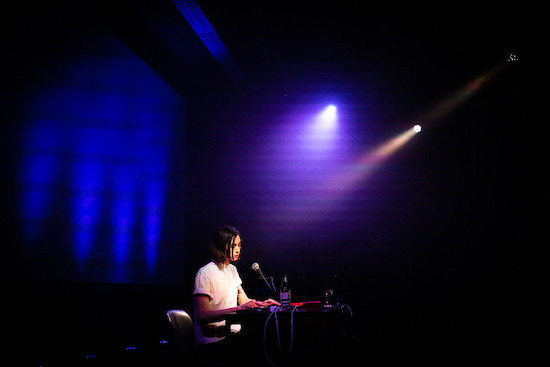
Claire Rousay by Tess Janssen
On Locking Down: An Insider’s View
It goes without saying that the last 18 months have been challenging for the Dutch music industry. The first lockdown was understandable, if exhausting. But “living with the virus” whatever that means, is proving very difficult to successfully regulate and will only lead to trouble and further problems.
And the new rules introduced by Den Haag slap bang in the middle of Le Guess Who? are a confusing hotchpotch of half measures that suit no-one. I am at a loss to see how they keep people safer than before. Seated events, (films and theatres, or cultural lectures) can carry on, if rock gigs or clubs can’t. (Presumably because Covid 19 virus particles don’t attend the cinema…) Once in a place, drinks can be served until 8pm but not afterwards, so those still attending an event will have to make do, or improvise.
Worse, the regulations were imposed almost overnight after a week of speculation, on a Friday night, in the middle of Le Guess Who?, a major festival that hosted around 8,000 international visitors. Those international visitors may have been shocked at the high-handed, opaque and rushed manner of imposed regulations, maybe thinking this is very “un-Dutch”. For those working in Dutch venues, the latest rules came as both another hurdle to jump and the latest confirmation that this increasingly quixotic, arbitrary and conservative government has very little idea how music or nightlife in general operates. I certainly can’t imagine it has any sympathy for how the sector rose to the challenges of the pandemic. Increasingly, many of us in the industry wonder if Rutte, de Jonge and company have ever even been to a venue, let alone any understanding of what putting on a show entails. To take my own venue, WORM in Rotterdam, since the spring of 2020 we have mutated into a (well ventilated and clean) radio station, a community centre for both high school students and the elderly, a soup kitchen on certain days, a debate and support centre for the city’s marginalised groups, a virtual event space live streaming gigs, an open air cinema and a barbers, as well as – when possible – a venue working with a 30 person capacity. This has been immensely rewarding but exhausting work. For their part, the organisers and production staff at Le Guess Who? deserve the utmost credit in being able to continue. Once again the country’s magnificent production and Front of House teams – who I consider unequalled in Europe – have to deal with making a silk purse from a sow’s ear.
Some artists this weekend were incredulous at the roll-out of the decision, one well-known international touring musician compared the high handed and rushed approach with the more mediated and gradual implementations in her own EU country.
But, again, we who work in the venues are not surprised, despite the country’s long reputation for good order. The new rules are the latest in a litany of misplaced policies that have plagued this weird government (meant to have stood down but still, by some concoction of procedure, still going). The long winter lockdown was topped up by a months-long curfew (the first since the occupation of World War 2). The incentive to get young people vaccinated – the infamous Dansen met Janssen campaign (“Dancing with the Janssen vaccine”) saw an overnight explosion of infections, simply because the official messaging inferred that young people could go clubbing immediately after their jab, not waiting two weeks to let immunity build up. Currently, it seems the booster jab roll-out is slow. To top it all, in late summer, the country was treated to the spectacle of a government minister singing a little song on TV about throwing his mask away and never seeing it again. At least Matt Hancock had the “dignity” to pretend to cry.
I’m not one to speculate but the longer this lot keeps tinkering to no effect, the less likely they will carry anyone with them. Especially as cases rise with more restrictions in place. Oh for a new Provo, or Punktijd.
Richard Foster
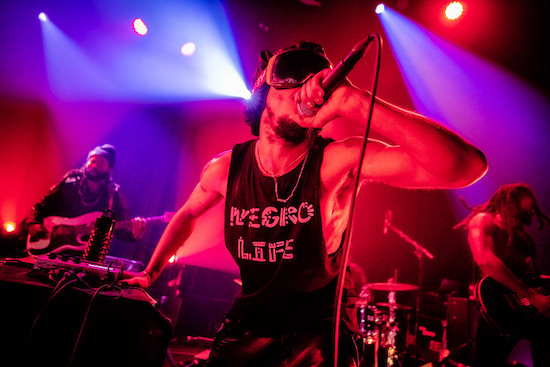
Pink Siifu by Ben Houdijk
A Medicine For Melancholy
Late to the show? I walk into Le Guess Who? in Utrecht on the fourth day of the festival and on the back of two other festivals haunting me with their death grip of dissolution facing lockdown measures all over Europe. Two days ago, I sat in Germany and heard about the new measures the Dutch government planned to curb yet another rise of infections and subsequent stress on intensive care hospital beds. For a festival, especially a music festival, changing half way from standing to seating is a regression of the evolution of humankind. It is the domestification of the dancing and moshing homo-festivalensis into a glued-to-furniture, awkwardly wailing and shaking legs left and right and generally motorically questionable creature. As the rule of any festival has it – its last day always has a goodbye ingrained into it – workers packing up in the background, gastronomy not in full fling anymore, noise levels considerably down in the waiting areas. But especially now that an 8pm cutoff for bars and restaurants has been announced, the extension of the experience into the streets of the city not possible anymore. As experiences go, they do not only happen in the moment, but walk with us in their aftermath, that riff reverberating, that drone shimmering, that voice echoing in our heads when talking to friends over a beverage and Roti or continuing on well into the night.
The last time I went to LGW? was in 2019 – all standing-pushing greatness. The lines are still what they used to be when waiting to get access during a concert. But this time it is different when I am queuing up at Ronda. In a break between songs I get taken to a seat similar to being in an opera house when I walk into my first concert of Bent Arcana, the supergroup gathered around one of this year’s LGW? curators John Dwyer. The man himself announces that they are just setting up for "another long jam". I observe the crowd – a sea of neatly seated, in a place where my eardrums were nearly perorated during Lightning Bolt. Nothing of that kind tonight. I watch the slowly building funk beat make a barperson move to my right, but I cannot dismiss the idea that this feels as if I was walking into a performance in a dream, detached from reality, resembling a wake where the Grateful Dead jam in front of me. I leave in order to join Alogte Oho & His Sounds Of Joy at Pandora. I find a spot on the central balcony and manage to catch the last three songs of the seven-piece, who fire up the atmosphere with their percussive vocals and urgent brass funk. There, I witness people trying to get out of their sedentary corset and wildly swing their limbs in episodic bursts of ‘get up’ and ‘sit down’.
I once heard filmmaker James Benning say that the average time a person spends in a gallery in front of a painting or an object was seven seconds. As vague as this number is – always depending on the individual of course – I have the feeling my first hour might continue in this fragmented way until the end. This includes a later interlude when I miss Taqbir with a friend due to overcrowding and we have an intimate listening session in the queue, around two corners and a flight of stairs of what sounded like a great concert from where we were standing. Like a novice, I remember that it takes time to get into the rules, spaces and people at a festival again. Thus, when I walk out of Pandora with the intention to see Fly Siifu next – I only make it around the corner to join a what seems like a kilometer-long queue leading up to the highest TivoliVredenburg outpost, Cloud Nine. Now, I haven’t lived in the Netherlands for three years and learned nothing. Seeking a Dutch solution to actually see a concert from the beginning now, I join a kind couple further up the field who take me under their wing and we become the closest of friends for around three honest minutes until we reach the hall in Cloud Nine to kiss goodbye to our recent familiarity in an instant and dart to our preferred seats, independently. Fly Anakin and Pink Siifu pour out – onto the front of the stage and behind decks and laptop respectively – and immediately draw the crowd into their spell with their situationist humour. They appear at their most playful here: alternating stage lights and volume often, their tracks mixing into each other into a stretched-out cloud. At times I find this anarchic, especially when Fly Anakin delivers his sharp lyrics, other times this seems a bit hectic, almost as a stage version of interruptions, clean ups, back to the start as if the looming disintegration of social life had already infiltrated the concert hall. But nevertheless, they manage to always re-center the concentration in the room, pushing and pulling with the audience’s engagement – culminating in a mutually humorous "Fuck the Police" exchange.
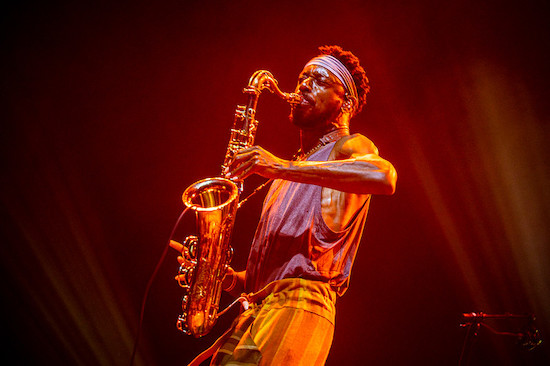
Sons Of Kemet by Jelmer de Haas
Seeing Sons Of Kemet in the Grote Zaal afterwards turns out to be revelatory. Bombing out with their set up of double drums, sax and tuba they massage the space with their booming foghorny goodness – before poet Joshua Idehen joins them centre stage with an incisive spoken word performance of ‘Field Negus’ that excels in its haunting anger, a moment of pure sonic hellfire: "Hashtag burnitall, just burn it all". I move, feeling punched, into the last session of the day, observing the eerily dissolving energy in the hallways on Tivoli’s steep escalators for one last ascent to Pandora, where I find my inner peace for a moment. Aksak Maboul are the perfect resting point now, but to say so about their performance would be reductive. Oscillating between dreamy and carefree French spoken pop on a sunny day in a cabriolet to the dark vocals of Véronique Vincent, Marc Hollander’s keyboards and Lucien Fraipont’s guitar at times seem to be just about to break into a harder register, resembling a pumping comparable to a ghost suppressed under a slate in the floor. Vincent’s additional live drawings projected on screen are at times abstract blots of black and red paint, then faces inked resembling a family of shapes. Bass player Faustine Hollander addresses the audience with a thank you midway through their concert, and mentions their happiness to be able to play at all with all the yes/no, ifs and nots in the last days. We have been there before: the melancholy of an atmosphere inevitably dissolving into nothingness is looming again, but Aksak Maboul’s delivery is exactly the right potion to take this sentiment under their wing and to just walk a little bit further, giving the hope that we will shed those chairs and all meet again standing.
Marius Hrdy

